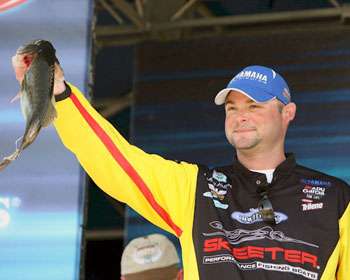
Midsummer bass fishing and brushpiles go hand-in-hand like a jig and a "pig." When the water temperatures skyrocket, many anglers can be found probing the depths for bass buried in these man-made fish magnets. Brushpiles can also be a deadly technique after the dog days have passed and bass begin to cruise the shallows — if you know where to put them and how to fish them.
Elite Series pro Bradley Hallman is an expert when it comes to planting productive early fall brush in his home state of Oklahoma. In preparation for upcoming tournaments, Hallman has been known to sink upwards of 100 brushpiles. Here's a breakdown of the process he goes through when sinking brushpiles for early fall bass.
"Especially in southern reservoirs, planting brushpiles in shallow water can be effective in late summer and early fall," says Hallman. "Typically when people talk about brushpiles, they are located in deeper water but I'm talking about 4 feet and shallower."
Hallman's quest to enhance the shallow habitat usually spans September and October. That's when bass in the Sooner State will begin to move shallow and gorge on schools of baitfish. When they aren't feeding, a well-placed brushpile is inviting relief from the sun. When planting shallow brush, Hallman focuses on flats and shallow areas of the lake rather than drop offs and creek channels.
"If the flats have the baitfish, you can drop a few houses for the bass to sit in when they're not chasing bait and that's typically when brushpiles pay off," explains Hallman. When planting shallow brush, Hallman prefers to drop his brushpiles within a certain area of the lake, usually in the clearest water he can find. With numerous piles in close proximity, he can rotate through them and pinpoint the most productive ones.
While the pattern may seem like a cinch, Hallman is quick to point out that many shallow brushpiles won't produce. "From my experience, you can plant 20 brushpiles and maybe two or three of them will end up holding bass. It just depends on where the bait is and how the bass are moving," he allows.
When it comes to making shallow brushpiles, Hallman almost exclusively uses freshly cut green willow tree branches. "When the lakes are low, there's a saying, 'When the water isn't in the willows, bring the willows to the fish,' " Hallman divulges. "You would be amazed at how much cover and shade a few willow branches can create when they're underwater."
To anchor the willows to the bottom, Hallman has used everything from old lawnmower blades to rocks to homemade buckets of concrete. He cautions that it's easy to get carried away and use an anchor that is too heavy. "You're better off using a lot of smaller weights than one big weight. It's easier to maneuver and take care of in the boat," he explains. Hallman's favorite anchor is a 20-pound chunk of cement with a section of rebar. The weight is heavy enough to anchor the brushpile to the bottom and the rebar offers an easy location to attach the brush pile.
It's also important to know if placing cover in a lake or river is legal — a few states prohibit the practice.
Planting and finding the right brushpiles can be a time consuming challenge, but Hallman says that a well-placed brushpile has the potential to pay immediate dividends. "You can plant green willow trees and if they're in the right spot, you can plant them at noon and there will be a bass in there by the end of the day."




